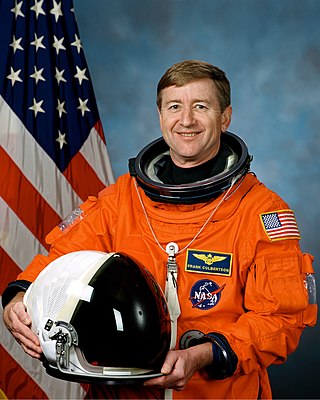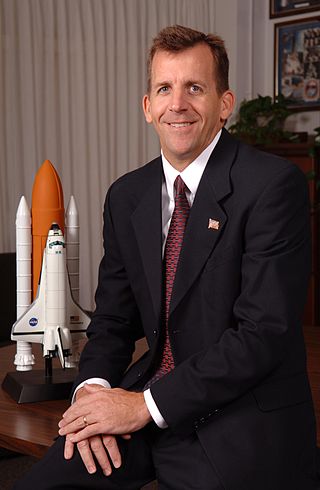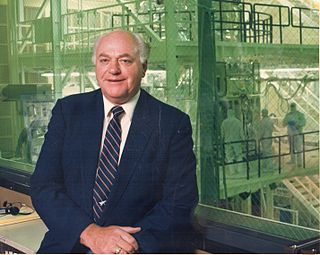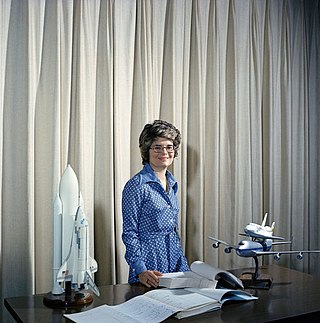
Jon Michael Smith (born September 6, 1938) is an American scientist/engineer, retired NASA officer, and author, who developed the numerical integration technique known as T-integration. [1] [2]

Jon Michael Smith (born September 6, 1938) is an American scientist/engineer, retired NASA officer, and author, who developed the numerical integration technique known as T-integration. [1] [2]
Born in 1938, Smith holds a Bachelor of Science degree in Physics from the Jesuit Seattle University. He attended the Harvard Business School's six-week Advanced Management Program, and a past member of the MIT Sloan School of Management Complex Organizations Program.
Smith worked for NASA on their Space Shuttle program. He was the first marketing manager for the Space Shuttle. His contributions included the preparation of the pricing and use policy for the Shuttle and the first launch agreements with commercial users. Later he managed the Advanced Communication Technology Satellite experiments program and the commercialization of the NASA polar communications network. Mike retired from the NASA Johnson Space Center in Houston, Texas in January 2007.
When at NASA, Smith managed the special projects office in the Space Shuttle Program Strategic Planning office. His work dealt with NASA's response to the recommendations made by the Columbia Accident Investigation Board and with NASA's terminating the Space Shuttle Program. Prior to this assignment, he served as the Commercialization Manager for the Space Operations Management Office at JSC and served as the program manager for the Advanced Communications Technology Satellite Program.
Currently Smith is the proprietor of Jon M. Smith and Associates (JMSA), a Galveston Texas-based consulting firm whose expertise includes space commercialization initiatives & launch vehicle flight guidance and control systems. Also, JMSA is involved with commercialized telescopes and space based energy initiatives. His clients include NASA and Wyle Labs. [3]

John Howard Casper is a former American astronaut and retired United States Air Force pilot.

The Rogers Commission Report was written by a Presidential Commission charged with investigating the Space Shuttle Challenger disaster during its 10th mission, STS-51-L. The report, released and submitted to President Ronald Reagan on June 9, 1986, both determined the cause of the disaster that took place 73 seconds after liftoff, and urged NASA to improve and install new safety features on the shuttles and in its organizational handling of future missions.

STS-51 was a NASA Space Shuttle Discovery mission that launched the Advanced Communications Technology Satellite (ACTS) in September 1993. The flight also featured the deployment and retrieval of the SPAS-ORFEUS satellite and its IMAX camera, which captured spectacular footage of Discovery in space. A spacewalk was also performed during the mission to evaluate tools and techniques for the STS-61 Hubble Space Telescope (HST) servicing mission later that year. STS-51 was the first shuttle mission to fly a Global Positioning System (GPS) receiver, a Trimble TANS Quadrex. It was mounted in an overhead window where limited field of view (FoV) and signal attenuation from the glass severely impacted receiver performance. Full triple-redundant 3-string GPS would not happen until 14 years later with STS-118 in 2007.

Sidney McNeill "Sid" Gutierrez, is an American pilot and former NASA astronaut. Since retiring from NASA, Gutierrez has worked in several leadership positions at Sandia National Laboratories and Rocket Crafters Inc.

Frank Lee Culbertson Jr. is an American former naval officer and aviator, test pilot, aerospace engineer, NASA astronaut, graduate of the US Naval Academy, and member of the United States Astronaut Hall of Fame. He served as the commander of the International Space Station for almost four months in 2001 and was the only U.S. citizen not on Earth when the September 11 attacks occurred.

James Hansen Newman is an American physicist and a former NASA astronaut who flew on four Space Shuttle missions.

Ronald Anthony Parise was an Italian American scientist who flew aboard two NASA Space Shuttle missions as a payload specialist.

Paul William Richards is an American engineer and a former NASA astronaut. He flew aboard one Space Shuttle mission in 2001.
The Aerospace Corporation is an American nonprofit corporation that operates a federally funded research and development center (FFRDC) in El Segundo, California. The corporation provides technical guidance and advice on all aspects of space missions to military, civil, and commercial customers. As the FFRDC for national-security space, Aerospace works closely with organizations such as the United States Space Force (USSF) and the National Reconnaissance Office (NRO) to provide "objective technical analyses and assessments for space programs that serve the national interest". Although the USSF and NRO are the primary customers, Aerospace also performs work for civil agencies such as NASA and NOAA as well as international organizations and governments in the national interest.
Miguel Rodríguez is the Chief of the Integration Office of the Cape Canaveral Spaceport Management Office.

John F. Muratore is a former NASA systems engineer-project manager and launch director at SpaceX. He is well known in the aerospace circles for his gregarious and unconventional style and use of rapid spiral development to reduce cost and schedule for introducing technical innovations.
Criticism of the Space Shuttle program stemmed from claims that NASA's Space Shuttle program failed to achieve its promised cost and utility goals, as well as design, cost, management, and safety issues. Fundamentally, it failed in the goal of reducing the cost of space access. Space Shuttle incremental per-pound launch costs ultimately turned out to be considerably higher than those of expendable launchers. In 2010, the incremental cost per flight of the Space Shuttle was $409 million, or $14,186 per kilogram to low Earth orbit (LEO). In contrast, the comparable Proton launch vehicle cost was $141 million, or $6,721 per kilogram to LEO and the Soyuz 2.1 was $55 million, or $6,665 per kilogram, despite these launch vehicles not being reusable.

LeRoy Edward Cain is an American aerospace engineer who worked for NASA as a flight director, launch integration manager and deputy manager of the Space Shuttle Program. Cain may be best known to the public from footage and documentaries showing his work as the entry flight director for STS-107, the mission that ended in the catastrophic disintegration of Space Shuttle Columbia, February 1, 2003. Cain issued the famous "Lock the doors" command, initiating contingency procedures in mission control for the first time since the Space Shuttle Challenger disaster 17 years earlier.

Gerald D. Griffin is an American aeronautical engineer and former NASA official, who served as a flight director during the Apollo program and director of Johnson Space Center, succeeding Chris Kraft in 1982.

Livingston L. Holder Jr. is a former USAF astronaut in the Manned Spaceflight Engineer Program during the mid-1980s. He was assigned to fly as a military payload specialist on the Space Shuttle, but could not fly in space due to the Challenger accident in 1986.

Swales Aerospace was an employee-owned, small business aerospace engineering firm. The company offered a full range of aerospace engineering services. It was the global leader in the development and manufacture of two-phase thermal solutions for spaceflight applications, and it was a small satellite mission provider. In 2007, it was acquired by Alliant Techsystems.

Bertram Raoul Bulkin was an American aeronautical engineer who participated in the first United States photo-reconnaissance satellite programs and is best known for his role in building the Hubble Space Telescope.

Kenneth Stanley Reightler Jr. is a former NASA astronaut.

Ivy Fay Hooks is an American mathematician and engineer who worked for the National Aeronautics and Space Administration (NASA). She joined NASA after graduating from the University of Houston with a master's degree in mathematics and physics in 1965. Her first assignment was with the Apollo program, where she worked on the modeling of lighting on the Moon and the dynamics of the launch escape system, among other projects. She then went on to play an important role in the design and development of the Space Shuttle, being one of only two women engineers assigned to the original design team for the orbiter.